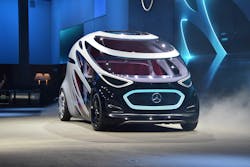Disruption. Creative destruction. Fail fast. Paradigm shift.
Frankly, I’m a little peeved by being pepper sprayed with these overused—and, more frequently these days, badly misused—buzzwords. Especially from a generation that doesn’t appreciate what they’re so excited to overturn and overrun. Neither the concept nor the conceit is particularly new, of course: Competition makes us better, or obsolete. (See Darwin, C.) But feel free to storm the figurative Bastille of your choosing, kids, just please quit talking about it beforehand.
Yet a lot of very serious people who run very serious companies have heeded the threat to their “legacy” business models, and they’ve put substantial resources to work to make sure their products and services don’t get embarrassed by Silicon Valley wunderkinder. And there’s a certain advantage to having a good relationship with capital markets, or at least a local banker: If you’re afraid you can’t beat that snot-nosed startup, buy it.
This combination of established steel and next-gen thinking was everywhere at this year’s IAA Commercial Vehicles show. Our coverage, beginning on Page 51, only scratches the surface of the world’s largest truck and trailer expo, but what was most striking about the show was how concepts that just a couple of biennia ago seemed distant dreams at best—and distracting show ponies at worst—have made it into production. In less than a decade. (The rollout of the new Mercedes-Benz Actros, Daimler’s flagship highway tractor, with its array of cool technology—including limited autonomous functions—was the most high-profile example, but essentially all of the major truck OEMs had something on hand that was just on the drawing board not so long ago).
The official theme of IAA this year was “Driving Tomorrow” but the real thematic meat was tucked away in a sideshow called New Mobility World. That’s where, according to the irksome promotional material, “digital experts, technology companies, startups, disruptors and the automotive industry come together to discuss and build the future of mobility.”
Marketing pitch aside, the trends and topics were on point, and completely in line with the product innovations on display at IAA: automation, networking, alternative powertrains, new mobility, Smart Cities.
In short, transportation concepts that were largely academic and theoretical a decade ago are suddenly achievable, and now it’s the hardware that’s driving the discussion in very practical and beneficial ways. After all, it’s one thing to imagine the possibilities of electric vehicles, or connected vehicles, or vehicles with various levels of autonomy; it’s another to get your hands on the equipment to truly discover what to do with it in the real world.
I got a hint of this genuine shift at the Work Truck Show earlier this year, as electric work trucks were being presented and taken seriously. At IAA, working, in-use, for-sale EVs were everywhere. That’s driven by the marketplace, of course, and the transportation needs in Europe are different than in North America.
Simply, in congested urban areas that were laid out for horse-drawn carriages, small, electric vehicles make perfect sense. And, it turns out, customers like them. And once a charging infrastructure is in place, it’s not a great leap for them to consider opportunities for larger EVs.
E-commerce also plays a big part in Europe, and it will in the US very soon as well. I got to drive the new eSprinter around the tarmac at Hanover Airport, and I don’t see any reason it wouldn’t be ideal in last-mile applications—if and when a charging infrastructure is in place and cost-effective.
And to that end, there’s another business-model shift in the works: Commercial vehicle OEMs want to make the adoption of EVs as seamless as possible, and they’re setting up divisions to consult on and even construct the charging infrastructure for customers, and that’s after doing the TCO math to make sure EVs will fit the application.
On top of the OEM emphasis on connectivity, telematics and data analytics, the industry looks to be laying the groundwork for Hardware-as-a-Service. Customers are no longer buying a truck, they’re investing in a suite of integrated transportation tools.
Connectivity was the buzzword of the week on the trailer side, as well. And we’re not just talking trailer tracking, or remote tire pressure monitoring. Again, spurred by e-commerce, camera and sensor systems demonstrated at IAA could scan a load space and relay details to dispatchers, and also direct load handlers to optimize placement for delivery.
Of course, OEMs were still happy to show off their latest over-the-top concepts. I’d be skeptical about the future of these completely autonomous pod vehicles with swappable bodies for passengers or freight, but—as I realized at IAA this year—there are a lot of smart people working in the CV business, and I shouldn’t underestimate them.
The future really is now.
About the Author
Kevin Jones
Editor
Kevin has served as editor-in-chief of Trailer/Body Builders magazine since 2017—just the third editor in the magazine’s 60 years. He is also editorial director for Endeavor Business Media’s Commercial Vehicle group, which includes FleetOwner, Bulk Transporter, Refrigerated Transporter, American Trucker, and Fleet Maintenance magazines and websites.
Working from Beaufort, S.C., Kevin has covered trucking and manufacturing for nearly 20 years. His writing and commentary about the trucking industry and, previously, business and government, has been recognized with numerous state, regional, and national journalism awards.

